engine OLDSMOBILE SILHOUETTE 1997 Owner's Manual
[x] Cancel search | Manufacturer: OLDSMOBILE, Model Year: 1997, Model line: SILHOUETTE, Model: OLDSMOBILE SILHOUETTE 1997Pages: 436, PDF Size: 21.87 MB
Page 186 of 436

Low Traction Light (Option)
If your vehicle has the
traction control system,
there will be a LOW
LOW
TRACTION
TRACTION light on the
instrument panel.
When your anti-lock system is adjusting brake pressure
to help avoid
a braking skid, or when your traction
control system is limiting wheel spin,
the LOW
TRACTION light will come on. Slippery road
conditions may exist
if this light comes on, so adjust
your driving accordingly. The light will come on and
stay on for four seconds when your anti-lock system
adjusts brake pressure for less than four seconds or
when your traction control system limits wheel spin
for less than four seconds. Otherwise, the light will go
out as soon as the anti-lock system stops adjusting brake
pressure or the traction control system stops limiting
wheel spin. The
LOW TRACTION
light also comes on briefly, as
a bulb check, when the engine is started. If the light
doesn’t come on then, have it fixed
so it will be there
to tell you when the system is active.
Engine Coolant Temperature Gage
This gage shows the
engine coolant temperature.
If the gage pointer moves
into the red area, your
engine is too hot!
It means that your engine coolant has overheated. If you
have been operating your vehicle under normal driving
conditions, you should pull off the road, stop your
vehicle and turn off the engine as soon as possible.
In “Problems on the Road,” this manual shows what to
do. See “Engine Overheating”
in the Index.
2-98
ProCarManuals.com
Page 187 of 436

Engine Temperature Warning Light
This light will come on
when your engine gets
too hot.
If this light comes on, it means that your engine coolant
has overheated.
If you have been operating your vehicle
under normal driving conditions,
you should pull off the
road, stop your vehicle and turn
off the engine as soon
as possible.
In “Problems on the Road,” this manual
shows what to
do. See “Engine Overheating” in the Index.
Low Coolant Light
If this light comes on,
your system
is low on
coolant and the engine
1+1
may overheat.
To prevent damage to your engine, immediate action .- IS requlred.
See “Engine Coolant”
in the Index and have your
vehicle serviced as soon as possible.
2-99
ProCarManuals.com
Page 188 of 436

Malfunction Indicator Lamp
(Service Engine Soon Light)
SERVICE ENGINE
SOON
Your Oldsmobile is
equipped with a computer
which
rr mitors operation
of the fuel, ignition and
emission control systems.
This system is called
OBD I1 (On-Board
Diagnostics-Second Generation) and is intended to
assure that emissions are at acceptable levels for the
life
of the vehicle, helping to produce a cleaner
environment. The SERVICE ENGINE
SOON light
comes on and
a chime will sound to indicate that there is
a problem and service is required. Malfunctions often
will be indicated by
the system before any problem is
apparent. This may prevent more serious damage to
your vehicle. This system is also designed to assist
your service technician
in correctly diagnosing any
malfunction.
NOTICE:
If you keep driving your vehicle with this light
on, after a while, your emission controls may not
work as well, your fuel economy may not be as
good and your engine may not run as smoothly.
This could lead to costly repairs that may not be
covered by your warranty.
This light should come on, as a check to show you it is
working, when the ignition is on and the engine is not
running.
If the light doesn’t come on, have it repaired.
This light will also come on during
a malfunction in one
of two ways:
0
a
Light Flashing -- A misfire condition has been
detected. A misfire increases vehicle emissions and
may damage the emission control system on your
vehicle. Retailer or qualified service center diagnosis
and service is required.
Light On Steady -- An emission control system
malfunction has been detected
on your vehicle.
Retailer or qualified service center diagnosis and
service may be required.
2-100
ProCarManuals.com
Page 189 of 436
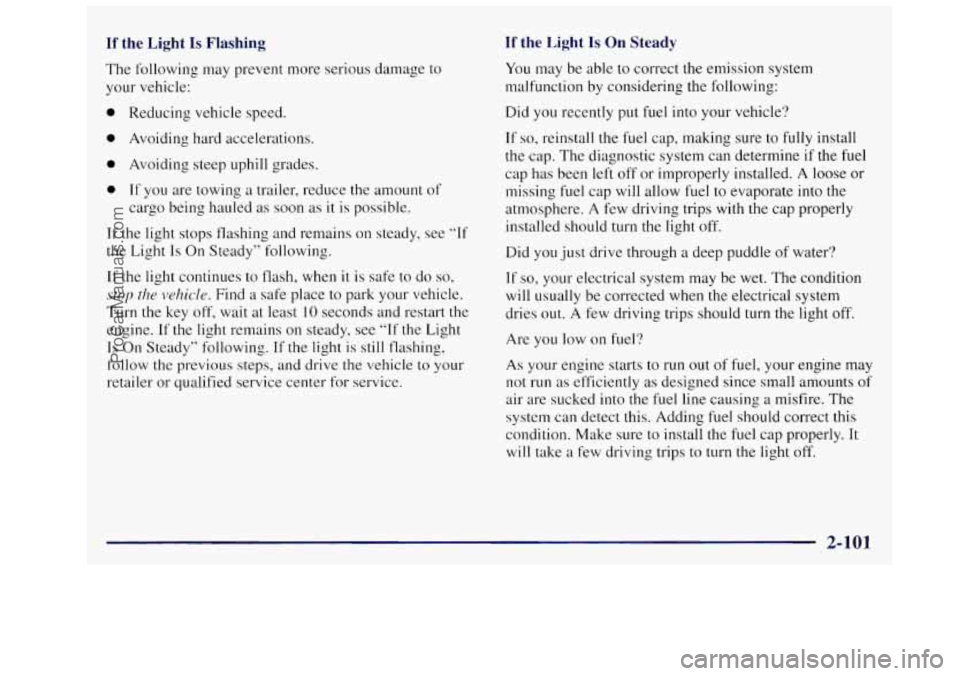
If the Light Is Flashing If the Light Is On Steady
The following may prevent more serious damage to
your vehicle:
0 Reducing vehicle speed.
0 Avoiding hard accelerations.
0 Avoiding steep uphill grades.
0 If you are towing a trailer, reduce the amount of
cargo being hauled as soon
as it is possible.
If the light stops flashing and remains on steady, see “If
the Light Is On Steady’’ following.
If the light continues to flash, when
it is safe to do so,
stop the vehicle. Find a safe place to park your vehicle.
Turn
the key off, wait at least 10 seconds and restart the
engine. If the light remains on steady, see
“If the Light
Is On Steady” following. If the light is still flashing,
follow the previous steps, and drive
the vehicle to your
retailer or qualified service center for service. You may be
able
to correct the emission system
malfunction by considering the following:
Did you recently put fuel into your vehicle?
If
so, reinstall the fuel cap, making sure to fully install
the cap. The diagnostic system can determine if the fuel
cap has been
left off or improperly installed. A loose or
missing fuel cap will allow fuel to evaporate into the
atmosphere. A few driving trips with the cap properly
installed should turn the light off.
Did you just drive through
a deep puddle of water?
IF so, your electrical system may be wet. The condition
will usually be corrected when the electrical system
dries out. A few driving trips should turn the light
off.
Are you low on fuel?
As your engine starts to run out of fuel, your engine may
not run as efficiently
as designed since small amounts of
air are sucked into the fuel line causing a misfire. The
system can detect this. Adding fuel should correct this
condition. Make sure to install the fuel cap properly. It
will take a few driving trips to turn the light off.
2-101
ProCarManuals.com
Page 190 of 436
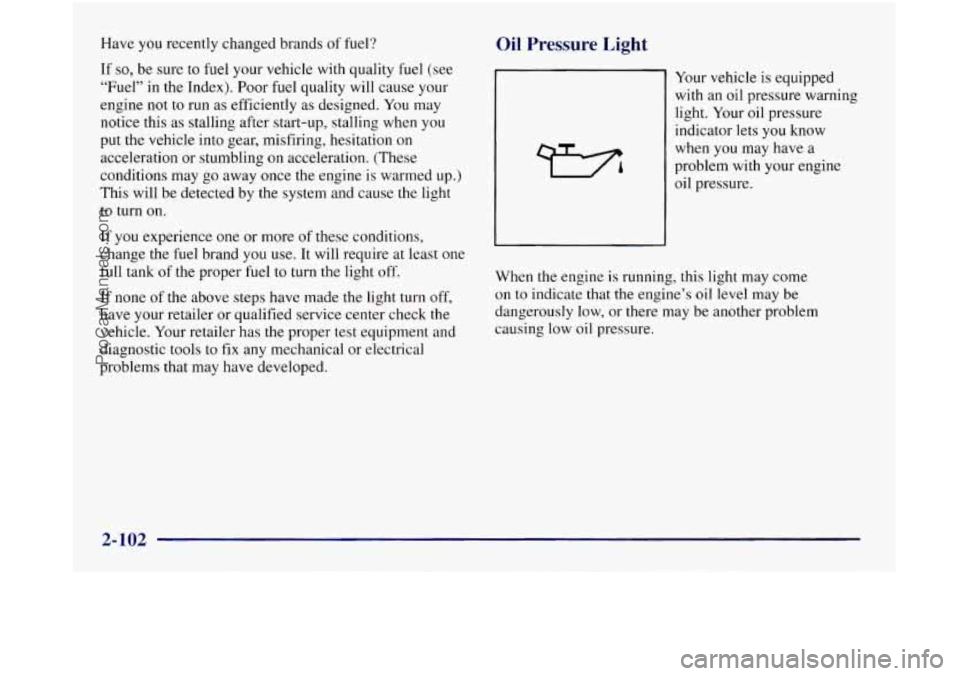
Have you recently changed brands of fuel?
If
so, be sure to fuel your vehicle with quality fuel (see
“Fuel” in the Index). Poor fuel quality will cause your
engine not to run as efficiently
as designed. You may
notice this as stalling after start-up, stalling when you
put the vehicle into gear, misfiring, hesitation
on
acceleration or stumbling on acceleration. (These
conditions may go away once the engine
is warmed up.)
This will be detected by the system and cause
the light
to turn on.
If you experience one or more of these conditions,
change the fuel brand you use. It will require at least one
full tank
of the proper fuel to turn the light off.
If none of the above steps have made the light turn off,
have your retailer or qualified service center check
the
vehicle. Your retailer has the proper test equipment and
diagnostic tools to fix any mechanical or electrical
problems that may have developed.
Oil Pressure Light
Your vehicle is equipped
with an oil pressure warning
light. Your oil pressure
indicator lets
you know
when you may have a
problem with your engine
oil pressure.
When
the engine is running, this light may come
on to indicate that
the engine’s oil level may be
dangerously low, or there may be another problem
causing low
oil pressure.
2-102
ProCarManuals.com
Page 191 of 436

Driving your vehicle with low oil pressure can
cause extensive engine damage. Have your vehicle
serviced immediately.
A CAUTION:
Don’t keep driving if the oil pressure is low. If
you do, your engine can become so hot that it
catches fire. You or others could be burned.
Check your oil
as soon as possible and have your
vehicle serviced.
I NOTICE:
Damage to your engine from neglected oil
problems can be costly and
is not covered by
your warranty.
Low Oil Level Light
If this light comes on, it
means your engine is low
on oil.
LEVEL
You need to check the oil level right away. Driving your
vehicle without enough oil can cause extensive engine
damage. Have your vehicle serviced immediately.
2-103
ProCarManuals.com
Page 193 of 436
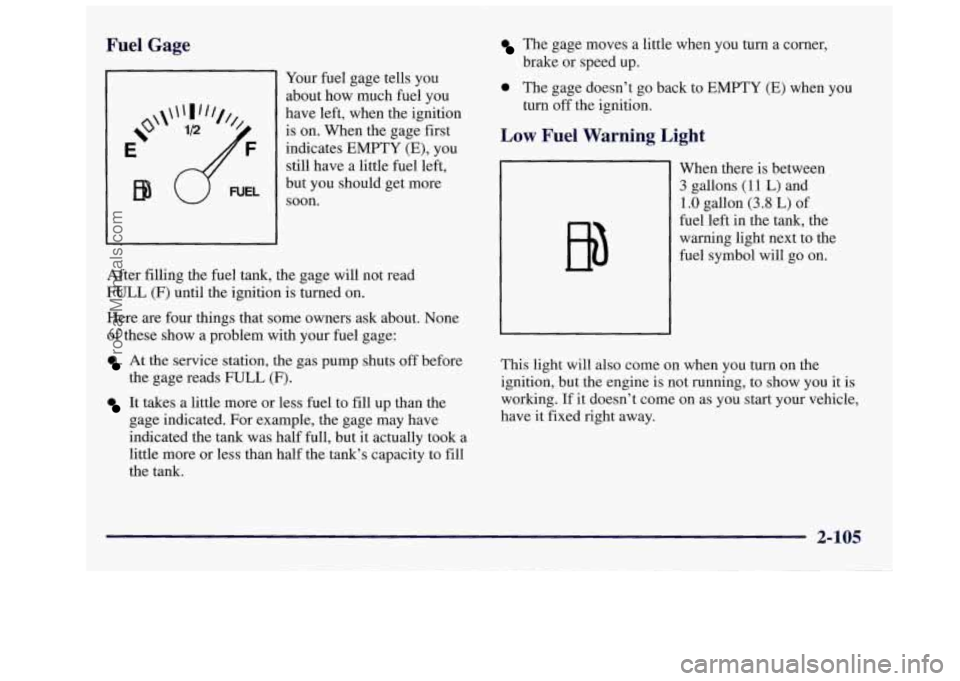
Fuel Gage
Your fuel gage tells you
about how much fuel you
have left, when the ignition is on. When the gage first
indicates EMPTY
(E), you
still have a little fuel left,
but you should get more
soon.
After filling the fuel tank, the gage will not read
FULL (F) until the ignition is turned on.
Here
are four things that some owners ask about. None
of these show a problem with your fuel gage:
At the service station, the gas pump shuts off before
the gage reads FULL
(F).
It takes a little more or less fuel to fill up than the
gage indicated. For example, the gage may have
indicated the tank was half full, but it actually took a
little more or less than half the tank’s capacity to fill
the tank.
The gage moves a little when you turn a corner,
0 The gage doesn’t go back to EMPTY (E) when you
brake or speed up.
turn
off the ignition.
Low Fuel Warning Light
EN
When there is between
3 gallons (1 1 L) and
1 .O gallon (3.8 L) of
fuel left in the tank, the
warning light next to
the
fuel symbol will go on.
This light will also come
on when you turn on the
ignition, but the engine is not running,
to show you it is
working. If it doesn’t come on as you start your vehicle,
have
it fixed right away.
2-105
ProCarManuals.com
Page 197 of 436
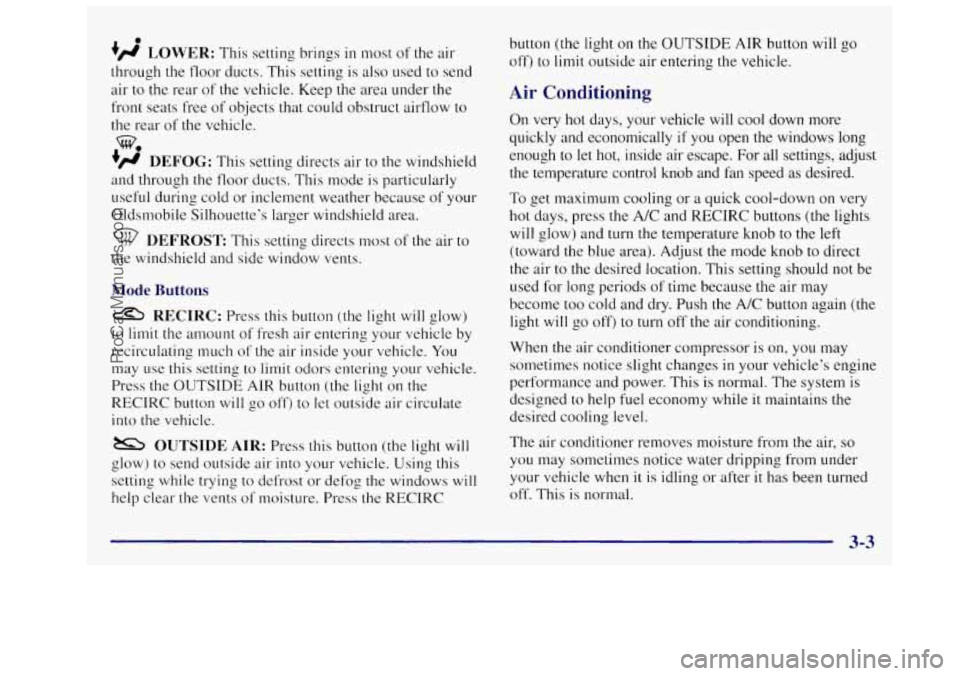
0
+fl LOWER: This setting brings in most of the air
through the floor ducts. This setting is also used to send
air to
the rear of the vehicle. Keep the area under the
front seats free of objects that could obstruct airflow to
the rear of the vehicle.
+’ DEFOG: This setting directs air to the windshield
and through the floor ducts. This mode is particularly
useful during cold or inclement weather because of your
Oldsmobile Silhouette’s larger windshield area.
w.
DEFROST This setting directs most of the air to
the windshield and side window vents.
Mode Buttons
RECIRC: Press this button (the light will glow)
to limit the amount of fresh air entering your vehicle by
recirculating much of the air inside your vehicle. You
may
use this setting to limit odors entering your vehicle.
Press the OUTSIDE AIR button (the light on the
RECIRC button
will go off) to let outside air circulate
into
the vehicle.
OUTSIDE AIR: Press this button (the light will
glow) to send outside air into your vehicle. Using this
setting while trying to defrost or defog the windows will
help clear the vents
of moisture. Press the RECIRC button
(the light
on the OUTSIDE AIR button
off) to limit outside air entering the vehicle.
Air Conditioning
will go
On very hot days, your vehicle will cool down more
quickly and economically
if you open the windows long
enough to let hot, inside air escape.
For all settings, adjust
the temperature control knob and fan speed
as desired.
To get maximum cooling or a quick cool-down on very
hot days, press
the A/C and RECIRC buttons (the lights
will glow) and turn the temperature knob to the left
(toward the blue area). Adjust the mode knob
to direct
the air to the desired location. This setting should not be
used for long periods
of time because the air may
become too cold and dry. Push the A/C button again (the
light will go off) to turn off the air conditioning.
When the air conditioner compressor is on, you may
sometimes notice slight changes
in your vehicle’s engine
performance and power. This is normal. The system is
designed to help fuel economy while it maintains
the
desired cooling level.
The air conditioner removes moisture from the air,
so
you may sometimes notice water dripping from under
your vehicle when
it is idling or after it has been turned
off. This is normal.
3-3
ProCarManuals.com
Page 198 of 436
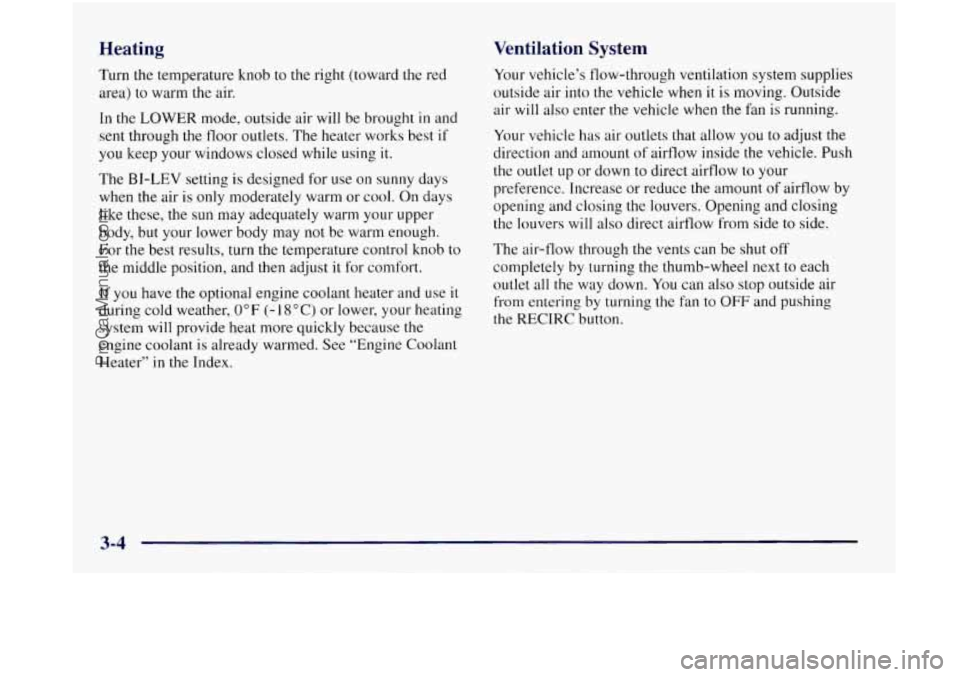
Heating Ventilation System
Turn
the temperature knob to the right (toward the red
area) to warm the air.
In the LOWER mode, outside air will be brought in and
sent through the floor outlets. The heater works best if
you keep your windows closed while using
it.
The BI-LEV setting is designed for use on sunny days
when the air is only moderately warm or cool. On days
like these, the sun may adequately warm your upper
body, but your lower body may not be warm enough.
For the best results, turn
the temperature control knob to
the middle position, and then adjust it for comfort.
If you have
the optional engine coolant heater and use it
during cold weather, 0°F (- 18 “C) or lower, your heating
system will provide heat more quickly because the
engine coolant is already warmed. See “Engine Coolant
Heater” in
the Index. Your
vehicle’s flow-through ventilation system supplies
outside air into
the vehicle when it is moving. Outside
air will
also enter the vehicle when the fan is running.
Your vehicle has air outlets that allow you to adjust the
direction and amount
of airflow inside the vehicle. Push
the outlet up or down to direct airflow to your
preference. Increase or reduce the amount
of airflow by
opening and closing
the louvers. Opening and closing
the louvers will
also direct airflow from side to side.
The air-flow through the vents can be shut off
completely by turning the thumb-wheel next to each
outlet all the way down.
You can also stop outside air
from entering by turning the fan to OFF and pushing
the RECIRC button.
3-4
ProCarManuals.com
Page 203 of 436

Setting the Clock for Systems with
NOTICE: Automatic Tone Control
Press and hold HR until the correct hour appears. Press
and hold
MN until the correct minute appears. Don’t use a razor blade or something else sharp
on the inside of the rear window. If you do, you
could cut or damage the warming grid, and the
AM-FM Stereo
I repairs wouldn’t be covered by your warranty.
I
Audio Systems
Your Deb@ audio system has been designed to operate
easily and give years
of listening pleasure. You will get
the most enjoyment out of it if you acquaint yourself
with it first. Find out what your Delco system can do
and how to operate all its controls, to be sure you’re
getting the most out of the advanced engineering that
went into
it.
Setting the Clock for Systems without
Automatic Tone Control
Press SET. Set will appear on the display for five
seconds. Within five seconds, press and hold
the right
arrow on the
SEEK button until the correct minute
appears. Press and hold the left arrow on
the SEEK
button until the correct hour appears.
Playing the Radio
VOLUME: This knob turns the system on and off and
controls the volume.
To increase volume and turn the
radio on, turn the knob clockwise. Turn it
counterclockwise to decrease volume.
3-9
ProCarManuals.com